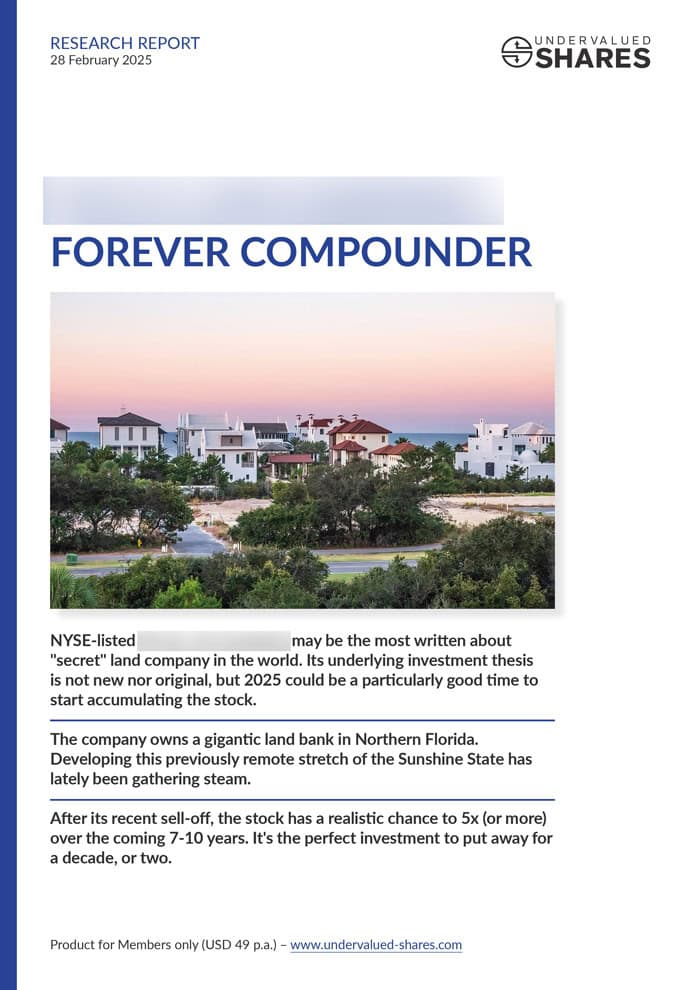2,000 years ago, Roman companies sold shares to the public to fund mega-projects.
The Roman public bought and sold these shares in offices on Via Sacra, the main street of ancient Rome that led to the Colosseum.
There were hypes and panics, driven by victories and defeats on the battlefield.
Is this Weekly Dispatch a belated April Fool's joke, or could this possibly have taken place?
It's commonly accepted that the modern-day joint stock corporation was invented in the Netherlands during the 17th century. However, some little-known history books and several serious scientists claim that the Romans were onto it two millennia earlier.
Who is right?
Speculators roaming the Forum Romanum
One of the advantages of editing an investment website with a high-calibre audience is that your readers send you valuable leads and ideas.
One reader with a knack for reading old books emailed how astonished he was to come across a mentioning of a Roman version of Wall Street.
"The New Deal in Old Rome" was published by H. J. Haskell in 1940. The original book is rare and expensive today, but reprints can easily be found. As it reports on page 11:
"Indications are there was a curiously high degree of commercial organisation in the ancient world. In the time of Cicero, in the last century before Christ, wealthy Romans were busily exploiting the eastern provinces. Companies of contractors were organised to construct public works and to collect government revenue, from which the contractors were took a large cut. They sold shares in offices on the Via Sacra, the Wall Street of Rome. Everybody, says the Greek historian Polybius, meaning all the country club crowd, bought them. … We may imagine how the bottom dropped out of Asiatic stocks on the Roman market when the news came of the concerted massacre of eighty thousand Italians at the instigation of the native ruler of an adjoining kingdom."
Haskell was no historian as such. He was a journalist and later editor of The Kansas City Star. His book compared the economy of ancient Rome with President Roosevelt's New Deal, and proved a small sensation at the time. It was clearly not a piece of academic research and written for the popular market. That said, under Haskell's leadership, his newspaper won two Pulitzer Prizes – at a time when the Pulitzer Prize still had real weight!
How much of Haskell's claims were true?
A quick Google search of "did the Romans have a stock market" produces contradicting results.
The first search result is an abstract from Prof. Pellegrino Manfra, a professor at City University New York: "Ancient Rome Economy and Investment: The Origins of the Stock Market
The origins of the stock market can be observed as far back as ancient Rome. The earliest example of organized market for equities can be found in the Roman Republic in second century B.C…. Back in Roman times, organizations called 'Societates Publicanorum' were formed that offered investments referred to as 'partes' or what we now know them as - shares. … The shares were tradable and had fluctuating prices based on the underlying project's success. …. The place where trading occurred was the forum, near the temple of Castor."
Prof. Manfra's conclusion couldn't be clearer.
However, three search results further down, you find a complete repudiation of his claims.
In 2016, Bocconi University in Milan put out a press release summarising a scientific article that its Prof. Manuela Geranio had published: "Ancient Rome Stock Exchange Is a Myth
Manuela Geranio, in a paper with Geoffrey Poitras, shows that modern claims of the existence of a market for shares of the societates publicanorum in the late Roman Republic are not supported by primary sources … Recent claims of trading in shares (partes) of tax-farming corporations (societates publicanorum) in the late Roman Republic can thus raise some skepticism. 'Upon closer inspection there is only brief discussion of possible share trading in a few sources that, in turn, depend fundamentally on a debatable interpretation of the commercial and legal context'. The location of the proto-stock-exchange near the temple of Castor results, for example, the fruit of ‘romanticized descriptions'. … The paper … highlights the need for more careful historical and legal analyses before concluding about the existence of its peculiar institutions in ancient times."
Did Haskell and Prof. Manfra produce a romanticised version of events?
Exploring the literature
When you investigate ancient Rome's economy without much prior knowledge, it's surprising how advanced it was.
In 2006, Peter Temin explored "The Economy of the Early Roman Empire" in The Journal of Economic Perspectives. The following are slightly re-arranged quotes for better readability.
"A prominent ancient historian estimated that the Italian peninsula was about 30 percent urbanized in the early Roman Empire. Using urbanization as an index of per capita income (as is routinely done in the economic history of recent centuries) suggests that GDP per capita in Roman Italy was between that in 1700 in the Netherlands and Italy or Spain, the most advanced European economies a century before the Industrial Revolution.
Romans loaned money to each other with great frequency. Some of these loans were to finance consumption; others were for production. ... For example, loans were used extensively to finance maritime trade in classical Athens, and maritime loans appear to have been widespread as well in Rome. ... Roman merchants and shippers could purchase insurance; they were able to borrow with repayment conditional on a safe return. Loans were numerous enough for contemporary commentators to speak of a market rate of interest separate from the rate on any particular loan, which has meaning only if it was possible for people to borrow at this rate more or less on demand."
Another notable work on the subject is "Banking and Business in the Roman World", published by Jean Andreau in 1999. It provides an in-depth study of all aspects of finance throughout six centuries of Roman history, and lays out how ancient Rome even had deposit-taking banks and a system for international bank transfers:
"Thanks to a number of papyri, we know that transfers were sometimes made from one bank to another, and we are at the beginning to gain a better understanding of the techniques used. A papyrus dating from the second century BC refers to a banker in Egypt with an account at one or several of his colleagues' banks. Similar examples are known in the first century BC and the first century AD."
Taken together, these features formed a set of advantages which few pre-industrial societies could rely on.
Have the Romans dabbled with an early version of the joint stock corporation and trading shares?
Maximalists and sceptics
The most common source cited as evidence that modern-day share trading took place in ancient Rome is "Publicans and Sinners", a 1972 book by Ernst Badian, an Austrian-born classical scholar who served as a professor at Harvard University from 1971-1998.
It describes how the Romans used "partes (shares) in public companies" and traded "over the counter" based on a "register" of shareholders that the companies kept. It all sounds like the ancient Romans did have an early version of a stock market!
Remarkably – or maybe rather unsurprisingly – Badian also described how politicians were not allowed to be shareholders in some companies but found ways around the ban:
"I would suggest that the shares traded in 59 BC, about which we get our incidental information, were unregistered shares; an obvious means of evasion, of a thoroughly Roman sort, if senators were to be interested in the public companies; and also, of course, technically very convenient (as in certain modern analogues) where the maximum freedom of trading is wanted both by the company itself and by those buying a financial interest in it."
It looks like Rome had its own version of Nancy Pelosi:
"We are fully entitled to conclude that these unregistered – and, presumably, therefore, 'non-voting' – shares were widely held by senators at this time."
However, Badian also noted that shares were "widely held by other classes". Investing in companies would have become a common activity among those who were of means.
How credible is this 53-year-old work?
Badian was elected a fellow of the American Academy of Arts and Sciences in 1974, and in 1999 his native Austria awarded him the Cross of Honor for Science and Art. His work may be dated, but it's impossible to dismiss his writing as that of a crank.
Badian was an early member of a group that critics of this field of study today decry as the "maximalists" who allegedly were too aggressive in interpreting incomplete historical evidence in a favourable way. That said, this kind of criticism has not stopped other historians from making similar arguments in more recent times.
One such historian is Ulrike M. Malmendier, a German economist and currently a professor of economics and finance at the University of California, Berkeley. In 2009, she had published "Law and Finance 'at the Origin'" in the Journal of Economic Literature, arguing:
"The societas publicanorum flourished in a legally underdeveloped but politically supportive environment ... At the height of its development, the societas publicanorum resembled the modern shareholder company along several core dimensions: its existence was not affected by the departure of partners (differently from the regular societas, i.e., the Roman partnership) and it could issue traded, limited-liability shares. ... the Roman publicans were able to establish large-scale business operations when the governing class supported and, in fact, benefited from those businesses. Laws were reinterpreted to facilitate government lease holding without fundamental legal reforms. ... The lack of easily accessible evidence is likely the reason the societas publicanorum is relatively unknown in the history of the corporation."
Malmendier is noted for her work on behavioral economics, corporate finance, law, and economics. One database of scientists lists her as among the top 5% most cited economists. In 2013, she was awarded the Fischer Black Prize by the American Finance Association for her significant original research in finance.
Still, another group of equally serious scientists delivered a broadside to the whole idea of the Romans operating something worthy of comparing it to modern-day stock markets.
In 2015, Bocconi University's Manuela Geranio teamed up with Geoffrey Poitras to publish "Trading of shares in the Societates Publicanorum?
The often repeated modern claim of significant trading in 'shares of the societates publicanorum' (partes) during the late Roman Republic cannot be supported using the available 'primary sources'."
As the authors go on to argue, previous analysis of this field failed to take into consideration differences in language, nuances in interpreting complex terms, the historical context, and the lack of sufficient amounts of clear evidence.
"Even where elements related to possible share trading can be identified in the primary sources, evidence is often vague or questionable. ... To avoid semantic confusions, understanding the commercial and legal context for claims of share trading and other activities involving the societates publicanorum requires definition of important terms – shares, share trading, company, joint-stock company, corporation. Appropriate definition is essential to clarify various claims made in modern sources."
Geranio and Poitras argue that previous interpretations in this field relied too much on an "artful interpretation" of key terms.
Their conclusion is supported by the widely-known notion that the day and age a scientist lives in (as well as their language and culture of origin) can play heavily into the conclusions of research.
One eminent Roman economic historian, Tenney Frank, described this phenomenon in the early 20thcentury: "It is a commonplace … that historians often reflect the spirit of their own epoch in the interpretation of past ages … efforts at writing the history of Rome would itself furnish a picture of the changing Zeitgeist in the countries of the writers."
Thus, two contradictory views exist whether the Romans did have a stock market.
The maximalists claim that "There is evidence showing that at least some Roman companies functioned similarly to the joint-stock companies of the English and the Dutch in the 16th and 17th centuries'."
The sceptics claim that this is too fanciful an interpretation of what took place. They point towards Roman enterprises being more of an ad-hoc joint stock company that didn't have a formal charter and lacked permanence. Trading their shares would not have constituted a stock market in today's sense, if it even happened to a meaningful extent – all of which is shrouded in the relative dearth of primary source material.
When serious scientific work leads to such contradicting results, you have to ask…
Who is right, and who is wrong?
Roman commercial history is fascinating but also difficult.
Linguistic complexity alone makes definitive conclusions near impossible. For example, the entire legal concept of "societas" can be translated as "partnership" or "company" or "association", depending on the context and interpretation.
However, from a high-level perspective, the Romans seemingly did create an early version of corporation. Entities that pooled money to build, maintain, renovate, and operate public facilities such as streets, stalls, temples, markets, theatres, facilities for circus games, and aqueducts undoubtedly existed. There was even an entrepreneur class that vied to get into respected political circles using their wealth. Generously interpreted, some of these enterprises were the predecessors of today's vertically integrated corporation.

Brought to you by the Aqueducts and Sewers Corporation (ROM:ASC).
Just as much, it seems clear that Rome did not take this to the level of sophistication we would normally expect from even the most basic form of corporate entity and share trading.
Did it matter, though?
As Malmendier argued in her article, the Romans might not have needed that level of sophistication and detail. There was a political will to see such entities come into existence, which came combined with a can-do attitude and an excess of capital that was looking to be deployed.
At the risk of making a daring leap, I'd cite the example of Sark, i.e. the independently-governed island I live on. While Sark has no employment law, some employees have privately negotiated contracts. The absence of a clear legal basis does not need to prevent something from happening if there is a will, a need, and the culture to make it happen.
It appears that the Romans were less concerned with conceptual debates about law, and instead focused on dealing with the rapid transformation of their formerly small, closed agricultural economy into an open system that spanned the entire known world. To accommodate the practical needs of their growing economy, they pressed ahead with new concepts without revolutionising the underlying laws. Along the way, some existing laws were reinterpreted to facilitate what business had to get done. As the Brits would say, "they just got on with it".
That said, there might never be a conclusive answer as to whether these early forms of joint stock corporations led to an organised Rome stock exchange in today's sense. Factors that stand in the way of a clear conclusion include the following:
- With just 1m native Romans, ancient Rome's community was so small that business didn't require a formal, anonymous trading platform but was often based on personal connections and family ties. Was this a stock market, or just citizens trading with each other?
- The societas publicanorum was used for a wide range of projects that were not government-owned in the strict sense but also not an entirely private enterprise. Many of these companies were given the right to collect taxes on behalf of the empire as their primary source of revenue. What few historical records exist will largely deal with enterprises that were part-government and part-private. There will have been many subtle differences such as some investors taking "shares in state enterprises" whereas others took "shares of the public revenues". It's difficult to reconcile these differences with today's concepts of a private joint stock company, making like-for-like comparisons difficult.
- The financial features of being a shareholder in these entities seems to have straddled the border of equity and bonds – it was neither here nor there.
Combine all this with sources being scattered and incomplete, and it's unlikely you'll ever get a widely accepted, conclusive answer to the question asked in the headline of this article.
That all said, it comes with its own pitfall if anyone says the Romans did not have a stock market because the system lacked the sophistication we are now used to. This line of argument could just as much be extended to the Dutchmen who are today widely believed to have invented the modern-day joint stock company. Compared to today, the Dutch East India Company created in 1602 was also a very basic form of company, and its share trading was rudimentary. Should it be discarded on that basis? Just where do you draw the line?
If you spend a bit of time reading up on the economic and financial history of ancient Rome, it's difficult not to be both surprised and impressed by the level of sophistication it did reach. After its collapse, it took humanity until the 19th century to again approach the levels achieved back then in areas such as transport, infrastructure, and lifestyle.
It appears that there are valid arguments in favour of saying the Romans invented the stock market, if only an early version of it.
History isn't usually black and white, but a lot of grey. If you accept the grey, the Romans seem to have won hands-down over the Dutch.
Watch out for someone finding long-lost annual reports of Julius Caesar Enterprises, Imperial Legion Inc., and the Aqueducts and Sewers Corporation.
They may be out there.
Out now: P/E of 2.5 and >20% dividend yield with this coal stock
Looking for a deeply contrarian, deep value investment with high payouts and buybacks?
The latest Undervalued Shares research report – out this week – has one such stock in store for you. It's a coal stock, and it's currently trading at a bargain price.
In fact, it's the second time this stock is trading at such low valuation multiples. It was similarly cheap in 2021 and then soared by 15x.
It's unlikely that you'll see this stock do 15x again, but it should be a relatively low-risk 2-3x when the situation normalises – and you'll get plenty of dividends while you wait.
Out now: P/E of 2.5 and >20% dividend yield with this coal stock
Looking for a deeply contrarian, deep value investment with high payouts and buybacks?
The latest Undervalued Shares research report – out this week – has one such stock in store for you. It's a coal stock, and it's currently trading at a bargain price.
In fact, it's the second time this stock is trading at such low valuation multiples. It was similarly cheap in 2021 and then soared by 15x.
It's unlikely that you'll see this stock do 15x again, but it should be a relatively low-risk 2-3x when the situation normalises – and you'll get plenty of dividends while you wait.
Did you find this article useful and enjoyable? If you want to read my next articles right when they come out, please sign up to my email list.
Share this post:








